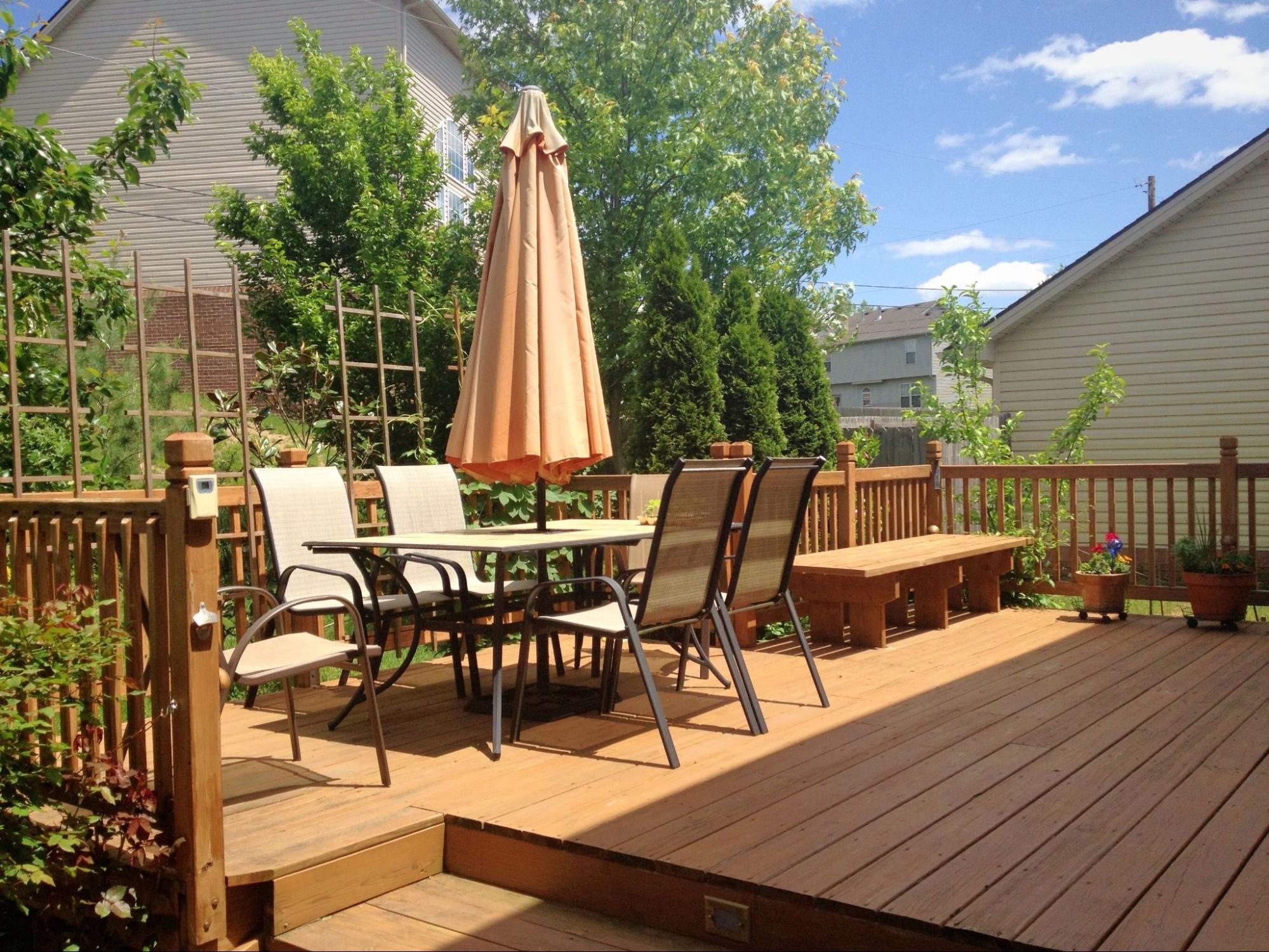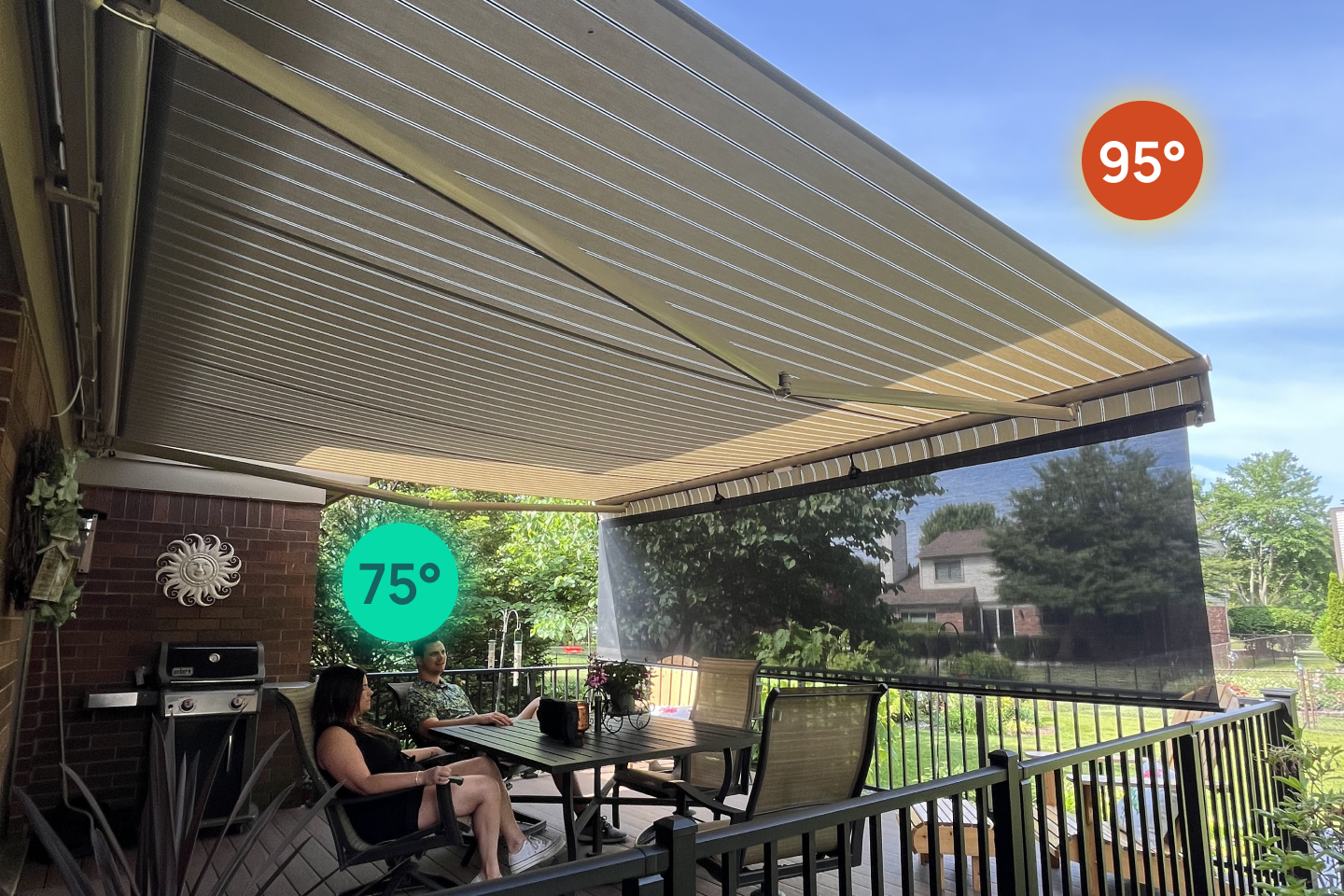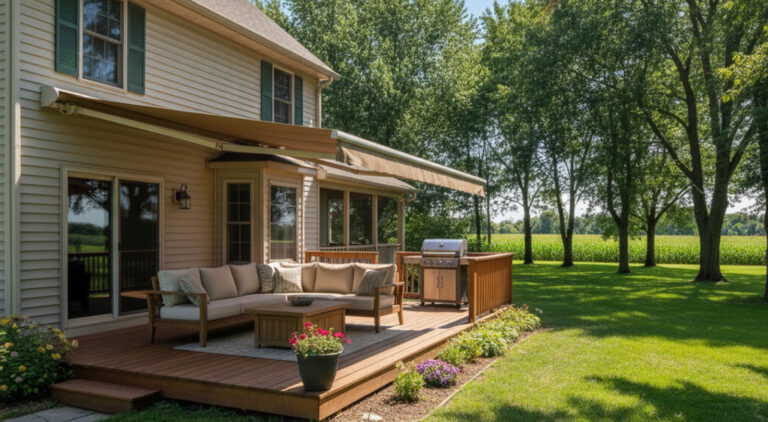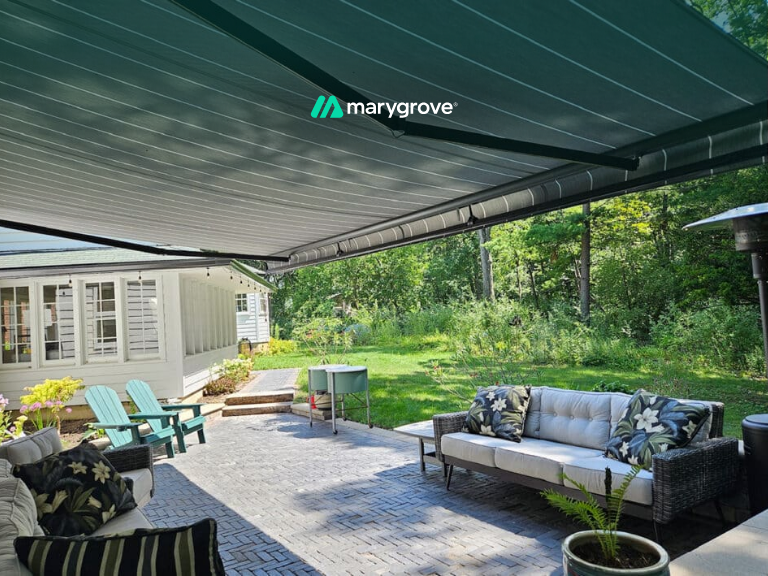Awnings reduce indoor heat by blocking solar radiation before it enters your windows. The result? Cooler rooms, lower AC costs, and more comfort, without sacrificing natural light or outdoor access.
Why Awnings Are One of the Most Effective Home Cooling Solutions
Direct sunlight through unshaded windows is a major source of indoor heat.
Awnings stop that heat before it enters, helping lower AC use, protect your HVAC system, and reclaim overheated spaces. Here’s how a quality awning makes an immediate impact:
- Blocks intense afternoon sun, especially from west-facing windows
- Cools indoor temps by up to 15°F
- Reduces cooling load and energy use by up to 36%
- Protects furniture, floors, and walls from UV damage
- Creates shaded zones for patios, balconies, and garden areas
- Enhances livability of open layouts and sun-facing rooms
- Adds long-term value without recurring costs
Whether you live in a warm climate or just want better control over indoor comfort, a well-designed awning can do more than you might expect.
It’s not just about cooling, it’s about how your space feels, functions, and supports the way you live, season after season.
Why Direct Sunlight Is Heating Up Your Home More Than You Think

Many homeowners underestimate how much heat their windows let in.
When temperatures climb, it’s often not the insulation or AC to blame, it’s unfiltered sunlight pouring through exposed glass.
That heat builds fast, especially in rooms with south or west-facing windows.
Glass Windows Act Like Heat Magnifiers
Direct sunlight passing through clear glass doesn’t just brighten a room, it transforms it into a heat trap.
Solar radiation enters and is absorbed by floors, walls, and furniture, turning into heat that lingers. Without exterior protection, this process repeats daily.
Afternoon Sun Often Causes Noticeable Heat Buildup
Morning sunlight is generally softer, but afternoon sun, especially from west-facing windows, tends to be more intense.
This can lead to a significant rise in indoor temperature, particularly in rooms without exterior shading.
Shaded spaces typically remain more stable and comfortable by comparison.
Helpful Resource → How to Shade Plants: Smart Garden Cooling Solutions
Three Types of Heat Are at Play
There’s more than just heat to consider. UV rays fade furniture and flooring.
Radiant heat warms surfaces directly. Ambient heat raises the room’s air temperature. Unshaded windows let all three in, affecting comfort and interior condition.
Why Indoor Fixes Aren’t Always Enough
Blackout curtains or blinds may help dim a room, but they don’t block heat already inside. Once sunlight penetrates the glass, it’s too late.
These interior solutions are reactive and don’t reduce overall thermal load.
Awnings and other exterior shades stop heat before it enters.
They intercept sunlight outside, reducing indoor temperatures naturally. Unlike blinds, they let in natural light while minimizing glare and unwanted warmth.
Once exterior shading handles the heat at the source, indoor cooling becomes far more efficient.
In the next section, we’ll look at how the right awning can go even further, helping you cut energy costs while keeping every room more comfortable.
Helpful Resource → Awnings Vs. Shade Sails: How To Decide Which Is Better
The Surprising Ways a Quality Awning Helps Cool the Inside of Your Home

Reducing sun exposure at your windows can quickly improve indoor comfort.
A well-placed awning turns overheated rooms into usable spaces, even in peak summer. And with the right features, it goes beyond cooling, delivering long-term comfort and efficiency.
Up to 15°F Cooler Indoors, Naturally
High-quality retractable awnings can drop interior temperatures by as much as 15 degrees, especially in homes with large south- or west-facing glass.
By limiting solar heat gain at its source, these systems help keep living rooms, upstairs bedrooms, and even open-concept kitchen areas far more comfortable during the day.
Energy Savings, Season After Season
Cutting heat at the window means relying less on your air conditioning system.
In fact, research from California’s Lawrence Berkeley Lab shows that fixed and adjustable awnings can reduce cooling loads by 24 to 36 percent in certain climate zones.
That kind of reduction doesn’t just lower energy bills, it also reduces strain on your HVAC system, helping extend its lifespan over time.
Smart Features, Smarter Results
Motorized retractable awnings offer smart-home compatibility and built-in wind sensors.
If a storm rolls in, the awning retracts automatically to prevent damage, giving you peace of mind and uninterrupted performance.
Full-cassette models keep the fabric clean, dry, and protected from UV damage, which reduces fading and extends product life.
Better Materials, Better Results
Fabric color plays a major role. Light-colored, UV-resistant fabrics reflect sunlight and help maintain cooler indoor temps.
Cheaper models with thin or uncoated fabric often trap heat or wear out faster.
And when it comes to projection, a 12-foot awning offers significantly more shade coverage than a 10-foot one, especially for taller windows or open patio doors.
Beyond Cooling: Unexpected Benefits
Awnings do more than regulate temperature.
They can turn sun-drenched home offices into productive, glare-free spaces. They keep dining areas cool and inviting for evening meals.
Open-concept rooms with sliding doors become usable for entertaining, and shaded hallways connecting indoor and outdoor zones become places for quiet reading or hosting guests.
With the right awning in place, every square foot of your home starts working harder, cooler, quieter, and more enjoyable.
Next, let’s explore how the cooling benefits extend beyond the walls of your house.
How Awnings Expand Cool, Usable Outdoor Living Space

A quality awning doesn’t just improve life inside the home, it completely transforms your outdoor experience.
Whether you’re working from your patio, hosting friends for a summer dinner, or simply trying to protect your garden, exterior shade delivers more than comfort.
It opens up entirely new ways to enjoy your space.
A Cooler, More Comfortable Backyard
When retractable awnings are extended over patios, decks, or balconies, they can lower ambient temperatures by as much as 20 degrees.
That means a previously unusable outdoor area in the afternoon becomes a shaded retreat for lounging, dining, or reading, even in peak heat.
Better for You, Better for Your Plants
For garden lovers, the benefits go beyond personal comfort.
Awnings protect container plants from harsh midday sun and reduce the risk of leaf scorch. Shaded areas also retain more moisture, helping potted arrangements thrive through the summer.
Microclimates and Extended Use
Pairing an awning with a ceiling fan can create a breezy, shaded microclimate that makes outdoor spaces feel 10 degrees cooler still.
Add drop-down valances or retractable screens and you’ll block low-angle evening sun while increasing privacy and wind protection.
Protection for Furniture and Systems
Awnings help preserve outdoor furniture by minimizing UV exposure.
They also offer indirect benefits, such as shielding HVAC compressor zones from overheating, which improves efficiency and extends equipment life.
Flexible for All Home Types
Not every home allows for permanent installations.
That’s why portable or freestanding options exist, especially for renters or those in condos.
And for homes with large sliding doors or open-air layouts, strategically placed awnings can also help cool adjacent interior spaces.
From better backyard comfort to longer-lasting equipment and greenery, outdoor shading expands what your home can offer year-round.
But to get the most from your investment, placement is everything, some spots cool faster, last longer, and perform better than others.
Best Places to Install Awnings for a Naturally Cooler Home

Where you install your awning matters just as much as the type you choose.
Strategic placement can improve airflow, block intense heat, and make both indoor and outdoor areas noticeably more comfortable.
Whether you’re dealing with hot upstairs rooms or a patio that’s too warm to enjoy, here are the most effective spots to install an awning:
Over South- or West-Facing Windows
These windows receive the harshest sun during the hottest parts of the day.
Awnings here can reduce solar heat gain significantly and help cool down bedrooms, living rooms, and kitchen areas that typically overheat.
Above Sliding Glass Doors
Glass doors act like heat traps.
An awning here not only shades the glass, it also helps cool the connected indoor space and creates a smooth temperature transition from indoors to outdoors.
Patio or Deck Areas
A retractable awning over your main outdoor hangout zone can drop ambient temps by 15 to 20 degrees. It also makes the space usable for dining, relaxing, or even remote work during warmer hours.
Front Doors and Porch Areas

Shade at the entry keeps the front door area cooler, reduces heat transfer into the foyer, and protects guests or delivery packages from direct sun exposure.
Over Windows Near Home Offices or Media Rooms
If you’ve converted a spare room into an office or entertainment space, exterior shading can block glare on screens and maintain a more stable, focused indoor climate.
Above Garage or Utility Room Windows
These areas often trap heat that then leaks into the house. Awnings can reduce that buildup, indirectly keeping your interiors cooler and more efficient.
Over Side Doors or Secondary Entryways
Side doors often go overlooked, but they can contribute to interior heat gain. Shading them keeps connecting hallways or mudrooms cooler and more functional.
Placing your awnings where the sun hits hardest gives you the best return in comfort and energy savings.
Also Read → Front Door Awnings: Styles, Materials & Smart Options
Will an Awning Cool My House?

Absolutely, when it’s done right.
A well-placed, properly sized awning made with durable, heat-reflective materials can make a dramatic difference inside and out.
Homes with south- or west-facing windows benefit the most from awnings. Add smart features like motorized controls and built-in wind sensors, and the gains are even greater.
These systems retract automatically during bad weather, protecting both your awning and your home.
With the right setup, you’ll cool your interior, make your patio more usable, and ease the load on your AC system.
You’ll also cut energy costs over time. But results depend on the details, projection, fabric quality, and angle all matter.
That’s why expert guidance is key.
Ready to cool your home the smart way?
Marygrove offers full-service awning installations with fast lead times, professional sizing, and in-house support every step of the way.


